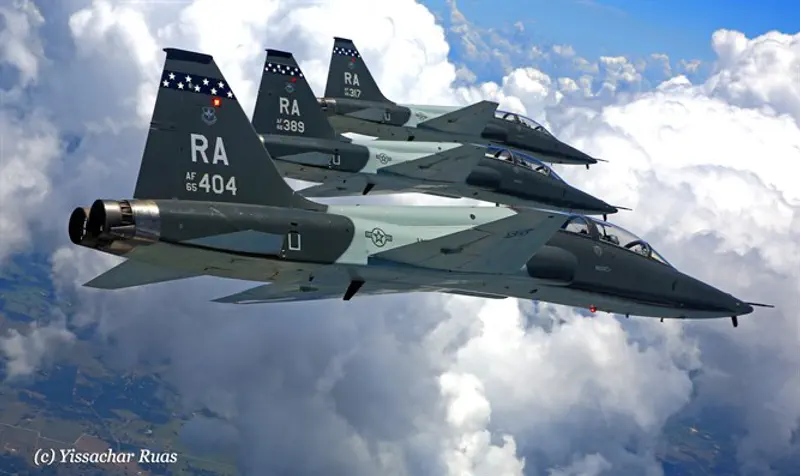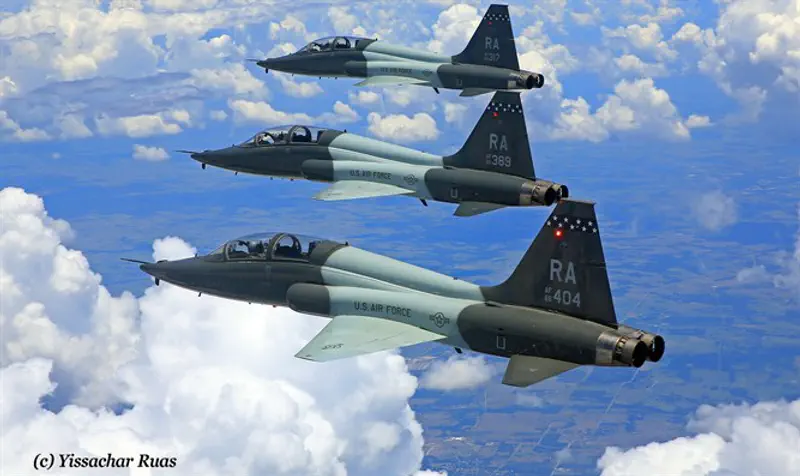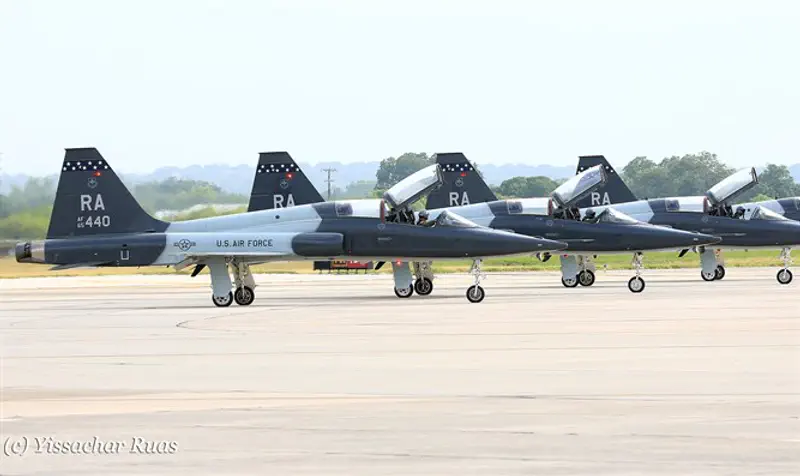Last week I was present at the Israeli Air Force Graduation ceremony in Hatzerim, among the stars of the show is the IAF Aerobatic display team. All of whom are instructors at the IAF Academy.
While access to the IAF is extremely limited, I was privileged to be granted access only a week prior to a similar program, the United States Air Force Instructor Pilot Training. Almost 2 weeks ago I traveled to Randolph AFB located just outside San Antonio, Texas. Randolph AFB is home to the 12th Flying Training Wing, one of the USAF’s primary training bases.
Randolph AFB hosts various training Squadrons, among them the 560th Flying Training Squadron also known as the “Charging Cheetahs”. The “Cheetahs” fly the T-38C advanced trainer, the same aircraft USAF student pilots fly in their advanced stages of training.
The “Cheetahs” are in charge of producing Instructor Pilots for the US Air Force. This means that a pilot designated for assignment as an Instructor must first complete a training course within the 560th qualifying him to become an Instructor.

Fly in the backseat of what is basically a fighter jet? You won’t have to ask me twice.
To achieve this I had to pass several hurdles, among them, 2 days of studying emergency procedures and a medical examination by a USAF Flight Surgeon.

Since the T-38C is meant to train future fighter pilots, like other combat aircraft it has a bubble canopy and is equipped with an ejection seat, oh, and it can pull 7.5Gs. Most of my studying over the 2 days prior to my flight is directly related to ejecting from the aircraft and everything involved with it to make sure that if the need arises – I would know how to achieve this goal as safely as possible.
The abundance of information over these 2 days is just a fraction of what student pilots endure. The 560th trainees have an additional hurdle, for them it is the second time at least that they are familiarizing themselves with the Jet, but this time they are graded not only on individual performance but also on how good they are at relaying the information over to a Student Pilot.
The length of a typical Instructor course is 20 weeks
Most Air force student pilots from the time they set out as Cadets until they get wings can take as long as 2.5 years, and then another 2 years to get fully mission qualified in their final aircraft. For this reason, it is easy to understand why this job is not for everyone. There is a need for dedication and determination that exists in very few other vocations.

Most Instructor Pilots are experienced pilots who have done several combat tours before returning to teach student pilots the basics in Combat Airmanship.
The Instructor Pilot tasked with getting me in the air and assigned with showing me what the Cheetahs do is Lt Col Bill “MOSR” Johnson. In what can only be considered a sign from above if you are a man of religion, or an absolute freak coincidence if you aren’t, I had actually met Lt Col Johnson in the UK in 2014 when he flew the F-15E Strike Eagle.
As a “Strike Eagle” driver “MOSR” was in charge of coordinating the US contingent for Israel’s first “Blue Flag” exercise in 2012 and spent 4 months on the ground as a liaison splitting his time between Tel Aviv and Eilat.
Trading cold and gloomy British weather for sunny Texas is definitely a step up, but at the heart of things you can see Lt Col Johnson’s Combat orientation even when in a training role. Everything at the 560 FTS is dedicated to finding the best way to improve instructing which in return is meant to produce better and more capable combat aviators.

During my brief stay Instructors are evaluating VR systems and assessing its potential, every edge they can provide future instructors towards teaching students is explored and evaluated.
After 2 days of training and several briefings with Lt Col Johnson, I was interested in getting a feel from a “newbie” point of view, so I headed out to the neighboring 435th Flying Training Squadron where I spoke with a current student pilot Nick Atkins. Atkins was pretty clear on my upcoming experience “Its like a roller coaster, only times 10 and it feels like your whole body is just falling apart” when I asked what to expect his answer was –“A lot of fun and probably some vomit”.
Following 2 days getting back to school, on the morning of Day 3 it’s time for my physical. My heart is beating at 100 miles per hour, sure enough the nurse asks me “are you ok?” after taking my blood pressure. No, not really, I have flown across the Atlantic and spent 2 days of studying with everything riding on a doctor’s exam. People fail this part for various reasons, some fail on issues as trivial as height and weight. My worry is generally my heart rate which seems to explode before every exciting assignment. Finally after a thorough exam and me drinking a bottle of water to calm down, the Flight Surgeon clears me for flight…..its time to suit up!
We head over to the 560th squadron for the brief with the other pilots in our flight -
Major Brian “Porky” Caramello
Major Michael “NASCAR” Granberry
Major Brian “FRONT” Page
We brief on the various maneuvers the Instructors will be practicing today with various safety aspects that involve me being in the back seat. Following briefing it’s time to really suit up!
I have an assigned G-suit meant to keep the blood in the upper part of my body when Lt Col Johnson “pulls Gs” during his maneuvers. After putting it on, I grab my helmet bag and we head out to the truck that takes us to the 560th “line” of aircraft.
Randolph at the end of June is hot, very very hot, I am sweating buckets before ever making it to the jet, the heat is almost 120°F and humidity is towards the max as well. We want to roll out as quickly as possible since until we take off – we won’t have any air conditioning, I am literally sitting in a pool of my own sweat. Lt Col Johnson goes over ejection procedures one last time – reminding me that if he’s incapacitated and “if I have enough time” flip the switch and try to punch him out as well (oh dear).
Leaving me with that Lt Col Johnson starts up the engine, the T-38C Talon whines to life, it feels like the aircraft is rearing to go held in place only by “chucks” to keep it from rolling. After several instrument checks and “MOSR” making sure I am good to go one last time….we are off. Rolling out of the shaded line and out into the hot Texas sun towards the end of the runway to join the rest of the formation getting ready for take off.
We close our canopies, line up, and we are rushing down the runway, with our #3 at our side we take off. Immediately my body realizes that we are flying in something different. The pressure on my body is ongoing and there is a constant strain, I check myself back into reality because I came here to get good video and pictures and its time to get to work.
Lt Col Johnson is going over tactical maneuvers with #3 which spreads the flight of 4s aircraft into a tactical setting quite far apart. In a sequence of maneuvers which all are making me make a slew of noises and grunts to which at some point I thought was getting to be quite excessive – my G-suit all of a sudden inflated, my camera dug into my lap and I let out a little yelp. Seconds later Lt Col Johnson says “are you ok Mr. Ruas” to which I grunted out “it all inflated!” – “That’s what its supposed to do Mr. Ruas” is the laconic response I got from “MOSR”.
“How many Gs was that” I ask? “MOSR’s” response – “Almost 5”
One of the things that really hit me is that my whole time airborne I was fighting to think about what I needed to do while fighting off the elements of combat flight. Student Pilots have to perform sequences of much more complex maneuvers while fighting off the same elements as well as flying safely.
One of the ways students as well as seasoned Aviators do this is by vocalizing what they need to do and repeating their actions over and over. Lt Col Johnson explains to me the various elements but I can tell that he is also walking himself through every maneuver.
Flying in close formation with the other aircraft demands a great deal of attention and awareness, while I am fighting off the elements and grunting, Lt Col Johnson is keeping us a hair length off of the #3’s wingtip.
After showing me one more time how they set up to fight in combat, all of a sudden I hear “bingo fuel” which is our cue that our gas is running out and its time to return home.
Lt Col Johnson goes through his checklist as we approach “home” and we are on the ground smoothly just a few minutes later.
After returning to the line and turning off the engine I feel something in my chest pocket, the 2 barf bags I brought with me – unused and damp with sweat. Well Mr. Atkins, an important lesson was to be learned, the flight definitely felt crazier than a roller coaster, but some people are lucky to have rock hard stomachs.
Israel National News would like to thank Mr. Randy Martin of Randolph AFB Public Affairs and Lt. Col. Bill “MOSR” Johnson of the 560th Training Squadron for making this segment possible.